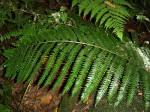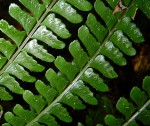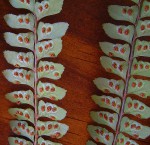Didymochlaena truncatula
Selected images: Click on each image to see a larger version and details of the record View all images (3)
Detailed records: Display species records QDS maps by: Google Maps Point records by Google Maps
Species details: Click on each item to see an explanation of that item (Note: opens a new window)
| Synonyms: |
Adiantum lunulatum Houtt. Aspidium truncatulum Sw. Didymochlaena dimidiata Kunze Didymochlaena lunulata sensu Sim |
| Common names: | |
| Frequency: | |
| Status: | Native |
| Description: |
Rhizome erect, forming a short caudex up to 25 cm in diameter; rhizome scales up to 20 mm long, pale to dark brown, subentire. Fronds tufted, erect to arching, firmly herbaceous to coriaceous, up to 2.5 m long. Stipe up to 60 cm long, straw-coloured, set with reddish-brown, twisted scales up to 1 cm long. Lamina up to 2 × 0.5 m, bipinnate, oblong-elliptic in outline, with a pinnate apical segment. Pinnae alternate, spaced apart, shortly petiolate, up to 25 × 4 cm, narrowly oblong, pinnate into 26 pairs of pinnules. Pinnules dimidiate, almost rectangular in outline, shortly petiolate, articulated, apex rounded to truncate, lower margin entire, upper margin irregular to toothed, hairless, deep glossy green above, paler below. Rhachis and secondary rhachis straw-coloured with pale brown scales. Sori 1-6 per pinnule, broadly elliptic, sometimes deeply sunk into the lamina, set close to the upper margin; indusia peltate, brown with pale rims and with a narrowly elongated stalk, entire. |
| Type location: |
|
| Notes: | D. truncatula can not easily be confused with other ferns; it has very characteristic almost rectangular pinnules with a dimidiate and entire lower margin and an irregularly crenate upper margin. |
| Derivation of specific name: | truncatula: cut of straight, referring to the square-shaped pinnule apices. |
| Habitat: | Deeply shaded moist situations in wet evergreen forest, along margins of streams. |
| Altitude range: (metres) | 300 - 1800 m |
| Worldwide distribution: | Tropical Africa and subtropical southern Afrika; also known from Madagascar, Asia and America. |
| FZ divisions: | E |
| Growth form(s): | Terrestrial. |
| Endemic status: | |
| Red data list status: | |
| Insects associated with this species: | |
| Spot characters: | Display spot characters for this species |
| Images last updated: | Sunday 9 September 2012 |
| Literature: |
Burrows, J.E. (1990). Southern African Ferns and Fern Allies. Frandsen, Sandton. Pages 299 - 300. (Includes a picture). Burrows, J.E. & Burrows, S.M. (1993). An annotated check-list of the pteridophytes of Malawi Kirkia 14(1) Page 98. Burrows, J.E. & Willis, C.K. (eds) (2005). Plants of the Nyika Plateau Southern African Botanical Diversity Network Report No. 31 SABONET, Pretoria Page 28. (Includes a picture). Chapano, C. & Mamuto, M. (2003). Plants of the Chimanimani District National Herbarium and Botanic Garden, Zimbabwe Page 20. Crouch, N.R., Klopper, R.R., Burrows, J.E. & Burrows, S.M. (2011). Ferns of Southern Africa, A comprehensive guide Struik Nature Pages 486 - 487. (Includes a picture). Da Silva, M.C., Izidine, S. & Amude, A.B. (2004). A preliminary checklist of the vascular plants of Mozambique. Southern African Botanical Diversity Network Report No. 30 Sabonet, Pretoria Page 10. Dowsett-Lemaire, F. (1989). The flora and phytogeography of the evergreen forests of Malawi. I: Afromontane and mid-altitude forests; Bull. Jard. Bot. Nat. Belg. 59(1/2) Page 25. Fischer E. & Lobin W. (2024). Checklist of Lycopodiopsida (clubmosses and quillworts) and Polypodiopsida (ferns) of Rwanda. Willdenowia 53(3) Page 160. Fischer, E. & Killmann, D. (2008). Illustrated Field guide to the Plants of Nyungwe National Park Rwanda. University of Koblenz-Landau. Page 86. (Includes a picture). Jacobsen, W.B.G. (1983). The Ferns and Fern Allies of Southern Africa. Butterworths, Durban and Pretoria. Pages 432 - 433. (Includes a picture). Mapaura, A. & Timberlake, J. (eds) (2004). A checklist of Zimbabwean vascular plants Southern African Botanical Diversity Network Report No. 33 Sabonet, Pretoria and Harare Page 6. Ntore, S. & al. (2024). Checklist of the vascular plants of Burundi Page 31. Roux, J.P. (2001). Conspectus of Southern African Pteridophyta. Southern African Botanical Diversity Network Report 13 Page 131. (Includes a picture). Roux, J.P. (2009). Synopsis of the Lycopodiophyta and Pteridophyta of Africa, Madagascar and neighbouring islands Page 119. Schelpe, E.A.C.L.E. (1970). Pteridophyta Flora Zambesiaca Page 220. (Includes a picture). |
Other sources of information about Didymochlaena truncatula:
Our websites:
Flora of Burundi: Didymochlaena truncatulaFlora of Malawi: Didymochlaena truncatula
Flora of Mozambique: Didymochlaena truncatula
Flora of Rwanda: Didymochlaena truncatula
Flora of Zambia: Didymochlaena truncatula
External websites:
African Plants: A Photo Guide (Senckenberg): Didymochlaena truncatulaAfrican Plant Database: Didymochlaena truncatula
BHL (Biodiversity Heritage Library): Didymochlaena truncatula
EOL (Encyclopedia of Life): Didymochlaena truncatula
GBIF (Global Biodiversity Information Facility): Didymochlaena truncatula
Google: Web - Images - Scholar
iNaturalist: Didymochlaena truncatula
IPNI (International Plant Names Index): Didymochlaena truncatula
JSTOR Plant Science: Didymochlaena truncatula
Mansfeld World Database of Agricultural and Horticultural Crops: Didymochlaena truncatula
Plants of the World Online: Didymochlaena truncatula
Tropicos: Didymochlaena truncatula
Wikipedia: Didymochlaena truncatula


